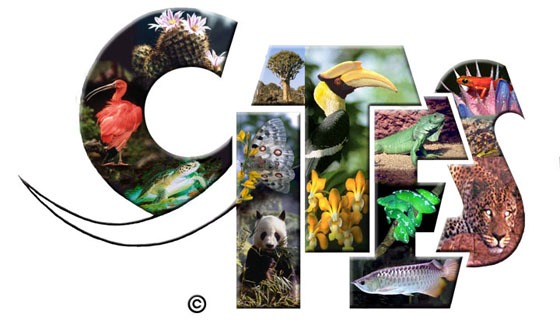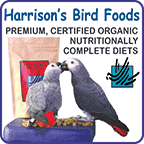Compiled by John Hayward of the National Theft Register
We feel that to have this site specialising in CITES matters will be of great help to all bird-keepers, especially those who breed parrots as there are certain restrictions and regulations when it comes to the 'trading' of such endangered species.
CITES is an acronym of the Convention on International Trade in Endangered Species of Wild Fauna and Flora. It also relates to our captive-bred Parrots at various levels and other animals considered to be in danger of extinction in the wild. CITES came into being in 1973 to prevent the over-exploitation of certain wildlife species whose numbers could be adversely affected by international trade.
There are now over 160 Countries worldwide who are signatory partners to the Convention, each having a management authority relating to the issuing of licences and permits which for the UK is Department for Environment, Food and Rural Affairs (DEFRA). In the USA the authority is US Fish and Wildlife Service (US FWS).
Classifications
The classifications are divided into two main sections. Appendix 1 and Appendix 2. Appendix 1 birds are those that are in potential danger of extinction. Appendix 2 relates to the remaining Psittacine species, all of which are in need of some protection to maintain populations where a potential danger of extinction could be a threat.
In Europe, the European Union has decided that the classifications need to be extended so we have Appendix 1-Annex A and Appendix 2-Annex B. For All other countries worldwide, only the term Appendix 1 and Appendix 2 are used.
All Parrots including cockatoos and macaws are subject to the regulations and are either placed on Appendix 1-Annex A or Appendix 2-Annex B. The most endangered species are on Annex A and all the others on Annex B. For those birds listed on Annex A, a specimen specific certificate is required from DEFRA or whenever they are traded. 'Trade' comprises of selling, advertising for sale, transporting for sale, offering for sale, displaying for commercial purposes and the sale of any offspring. In these cases you need a licence to sell the young and licences for the parent birds even though they are not themselves for sale. Annex A birds require either a closed identifiable ring or microchip prior to the application for the licence.
The Regulations not only cover the live bird but also the dead specimen, its parts and derivatives. To answer another regular query, a hybrid bird such as the 'Catalina Macaw' ( Blue and Yellow x Scarlet) if offered for sale requires the same licence due to the fact that the Scarlet is itself an Annex A listed bird. The anomaly however is that one can give an Annex A bird away as a gift and a licence is not required as it is not being 'traded'. However, should it subsequently be used for commercial breeding purposes, a licence must be applied for.
The Convention meets every two years to consider the classification of those species that require extra protection from endangerment such as the recently added Amazons. This is therefore an ever-changing scenario, so with the facility of this site, we now hope to keep all of our parrot owners fully up to date with any new developments both regarding the listings and the regulations.
John Hayward is the Co-ordinator of the National Theft Register previously a Detective Inspector/Wildlife Liaison Officer trained in such matters by the CITES Secretariat, Geneva.
For any further information in the UK call DEFRA (Department for Environment, Food and Rural Affairs) on 0117 372 8749 between 9am and 5pm:
Website: http://www.defra.gov.uk
For any further information in the United States call: USFWS (US Fish and Wildlife Service) on 1-800-344-WILD between 8:00 AM and 8:00 PM Eastern Time, Monday through Friday.
Website: http://permits.fws.gov
National Theft Register
John Hayward on 01869 325699
Appendix 1
Amazona arausiaca – Red-necked Amazon
Amazona barbadensis – Yellow-shouldered Amazon
Amazona brasiliensis – Red-tailed Amazon
Amazona finschi – Lilac-crowned Amazon
Amazona guildingii – St Vincent Amazon
Amazona imperialis – Imperial Amazon
Amazona leucocephala – Cuban Amazon
Amazona ochrocephala auropalliata – Yellow-crowned Amazon
Amazona ochrocephala belizensis – Yellow-headed Amazon
Amazona ochrocephala caribaea – Yellow-headed Amazon
Amazona ochrocephala oratrix – Yellow-headed Amazon
Amazona ochrocephala parvipes – Yellow-naped Amazon
Amazona ochrocephala tresmariae – Yellow-headed Amazon
Amazona pretrei – Red-spectacled Amazon
Amazona rhodocorytha – Rhodocorytha Amazon
Amazona tucumana – Tucuman Amazon
Amazona versicolor – Saint Lucia Amazon
Amazona vinacea – Vinaceous Amazon
Amazona viridigenalis – Green-cheeked Amazon
Amazona vittata – Puerto Rican Amazon
Anodorhynchus hyacinthinus – Hyacinth macaw
Anodorhynchus leari – Lears macaw
Ara ambigua – Great-green macaw (Buffons)
Ara glaucogularis – Blue-throated macaw
Ara macao – Scarlet macaw
Ara maracana – Illiger’s macaw
Ara militaris – Military macaw
Ara rubrogenys – Red-fronted macaw
Cacatua goffini – Goffins Cockatoo
Cacatua haematuropygia – Red-vented Cockatoo
Cacatua moluccensis – Moluccan Cockatoo
Cacatua sulphurea – Lesser Sulphur-crested Cockatoo
Cacatua sulphurea abbitti – Abbots Lesser Sulphur-crested Cockatoo
Cacatua sulphurea parvula – Lesser Sulphur-crested Cockatoo
Cacatua sulphurea citrinocristata – Citron-crested Cockatoo
Cyanopsitta spixii – Spix’s macaw
Cyanoramphus forbesi – Chatham Island yellow-fronted parakeet
Cyanoramphus novaezelandiae – Red-fronted parakeet
Cyclopsitta diophthalma – Coxen Coxen’s double-eyed fig parrot
Eos histrio – Red and blue lory
Eunymphicus cornutus – Horned parakeet
Geopsittacus occidentalis – Night parrot
Guarouba guarouba – Golden Conure
Neophema chrysogaster – Orange-bellied parrot
Ognorhynchus icterotis – Yellow-eared parrot
Pezoporus wallicus – Ground parrot
Pionopsitta pileata – Pileated parrot
Probosciger aterrimus – Palm Cockatoo
Propyrruha Couloni (formerly Ara Couloni) – Blue-headed macaw
Propyrruha Maracana (formerly Ara Maracana) – Blue-winged macaw
Psephotus chrysopterygius – Golden-shouldered parrot
Psephotus dissimilis – Hooded parrot
Psephotus pulcherrimus – Paradise parrot
Psittacula echo – Mauritus parakeet
Psittacula krameri (Ghana) – Ring-necked parakeet
Pyrrhura cruentata – Blue-throated parakeet
Rhynchopsitta pachyrhyncha – Thick-billed parrot
Rhynchopsitta terrisi – Maroon-fronted parakeet
Strigops habroptilus – Kakapo
Vini ultramarina – Ultramarine lorikeet



